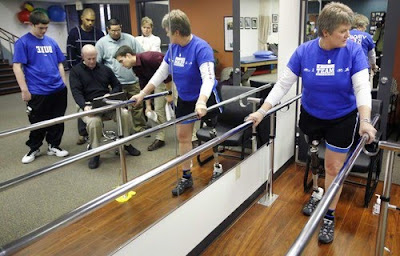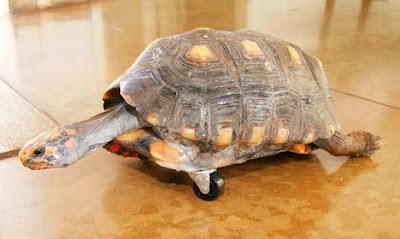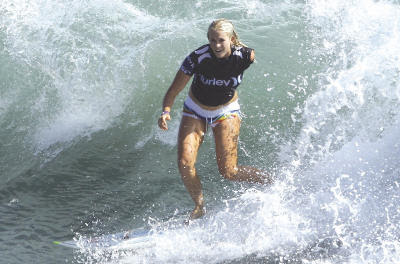
By Bill Lohmann
Published: March 27, 2011
» 0 Comments | Post a Comment
Late on a cool, gray afternoon, Robin Pugh Yoder ducked into an office, changed into a T-shirt and shorts, and headed for a little exercise — in a hospital parking lot.
She walked steadily yet cautiously, conscious not only of moving cars but also speed bumps, potholes and a persistent breeze that could, if she lost her balance, blow her over.
You notice things like that when you're 49 and learning to walk again.
"This whole process is slow and tedious and hard," said Yoder, who lost her right leg to cancer last August and is taking baby steps, literally, as she grows accustomed to a prosthetic leg. "Not just on a physical level, but mentally.
"My life has changed forever."
Some things, however, never change.
Yoder, an accomplished athlete, has regularly competed in the Monument Avenue 10K, and this year will be no different, other than she will be walking, not running. Her goal Saturday is not to finish in a specific time, but simply to finish, even if she has to use crutches.
This time last year, she was preparing for the 10K, the first race of the season, by running three days a week and swimming, lifting weights or exercising on elliptical machines three other days. Today, she's walking in parking lots and in her neighborhood, sweating through strenuous rehab sessions, and building her proficiency and endurance with an artificial leg. She prefers not to compare last year with today.
"I try not to think about that because … if I think about where I was a year ago it gets depressing and frustrating," she said. "But if I think about where I was in August, I'm really proud of myself.
"That's life before, and now there's my new life. My new life is just trying to live in my old world with my new body, and realizing I can still do the same things, but I'm going to have to learn to do them in a slightly different way."
Yoder, who lives in Chesterfield County and works as an oncology social worker at CJW Medical Center helping others through difficult periods in their lives, has a long history of athletic achievement and overcoming obstacles.
She was a high school basketball star headed to college on an athletic scholarship when she was diagnosed with bone cancer in her right leg. Doctors saved the leg, but her college basketball career was over. After graduating from East Carolina University, she served two years in the Peace Corps.
Through the years, Yoder competed in triathlons and was training for one last summer in honor of a friend, Lanie Evans, who was battling brain cancer, when she noticed an odd heaviness in her right leg. Soon after, she was diagnosed with cancer again — she believes it was caused by the radiation treatment from her first bout with cancer — but this time, circumstances made amputation the prudent course of action.
A month after surgery, she was walking on a prosthetic leg. A month after that, she was swimming. Soon, she was sitting on a bicycle.
She went full-bore into rehabilitation even while she was going through the grieving process that is normal when a limb is lost. She still dreams of her missing leg.
But patience is not something that comes easily to someone as driven, direct and goal-oriented as Yoder. Not long after she began walking on her artificial leg, a therapist casually mentioned shopping malls are good places to practice walking.
The therapist never suggested she go soon or alone, which is precisely what Yoder did. After creeping along the storefronts, hanging on to the walls and doorways, an overwhelmed Yoder managed to get to a bench, where she called a friend who offered to come pick her up.
After reading an online description of how she might run with a prosthetic leg, she decided it would be a good idea to practice, alone, in a narrow hallway in her home so that if she lost her balance, she could fall against one wall or another.
Unafraid to challenge herself, she has fallen numerous times in therapy and at home. She once strained her shoulder muscles catching herself awkwardly, so she has been in physical therapy for that, too.
Physical therapist David Lawrence, who sometimes has to push hard to get patients with new artificial legs to take the next step, has to encourage Yoder to slow down.

"With Robin, one of the challenges has been, how do you keep her motivated and working while at the same point holding back the reins so she doesn't hurt herself?" said Lawrence, founder of Lawrence Rehabilitation Specialists and The Gait Center. "I just try to keep her a little grounded."
Yoder's plan to walk the Monument Avenue 10K, a distance of more than 6 miles, less than eight months removed from amputation is "a little bit lofty," Lawrence said, but for Yoder, it's realistic.
"This is her coming-out party," he said.
And it will be a party. Yoder will be accompanied by a small army of more than 100 supporters sporting royal blue T-shirts emblazoned with the images of high-kicking dancers and the phrase, "Because We Can-Can, Robin Can-Can."
"She is stubborn and will dig in and do whatever it takes to meet her goal," said Amber Williams, a friend who has trained with Yoder for triathlons and will be among the blue-shirted supporters. "She's just the most honest, thoughtful, insightful person I've ever had the pleasure of spending time with.
"She's been a complete inspiration for me."
Everyone sees the determined Yoder, a woman with the seemingly relentless spirit who expects to run and ride a bicycle. What they don't necessarily see are the almost imperceptible strides she makes from one grueling therapy session to the next. They don't see her struggles with a poor-fitting socket of her artificial leg — what's left of her right leg above the knee has been shrinking since surgery — that complicate the already challenging walking process in which, as she put it, you're trying to make your hip think it's an ankle.
They can't see Yoder grieving for her friend Lanie, who died a few weeks ago and was her inspiration as she recovered from her own surgery. They don't see her fretting over her next set of scans, which are scheduled every few months, to make sure the cancer that was in her leg hasn't spread.
It's impossible for people to know just how many mornings Yoder would rather pull the covers over her head and pretend this didn't happen.
But she won't do that because of the people who encourage and inspire her — family, friends, co-workers and patients, physicians and therapists — and because as an athlete she knows only she can put in the work to make things better.
As daylight faded, she finished her long loop around the parking lot of the Thomas Johns Cancer Hospital, where she is co-founder and director of The Hawthorne Cancer Resource Center, past the garden for patients she started by digging in the dirt, past other hospital workers heading home for the day (she still had an evening support group of breast cancer survivors to lead). Many offered good wishes and encouragement.
"What everyone wants is for me to have a good ending, and it's going to be, I think," she said. "But people have to be patient and let me get there."
But patience is in the mind of the beholder. Yoder is already looking beyond the Monument Avenue 10K. She has been invited to participate in a mini-triathlon — running, biking and swimming — in Maryland in August. She can't help herself. She's making plans.
"I might can do it by then," she said. "It gives me a goal."















